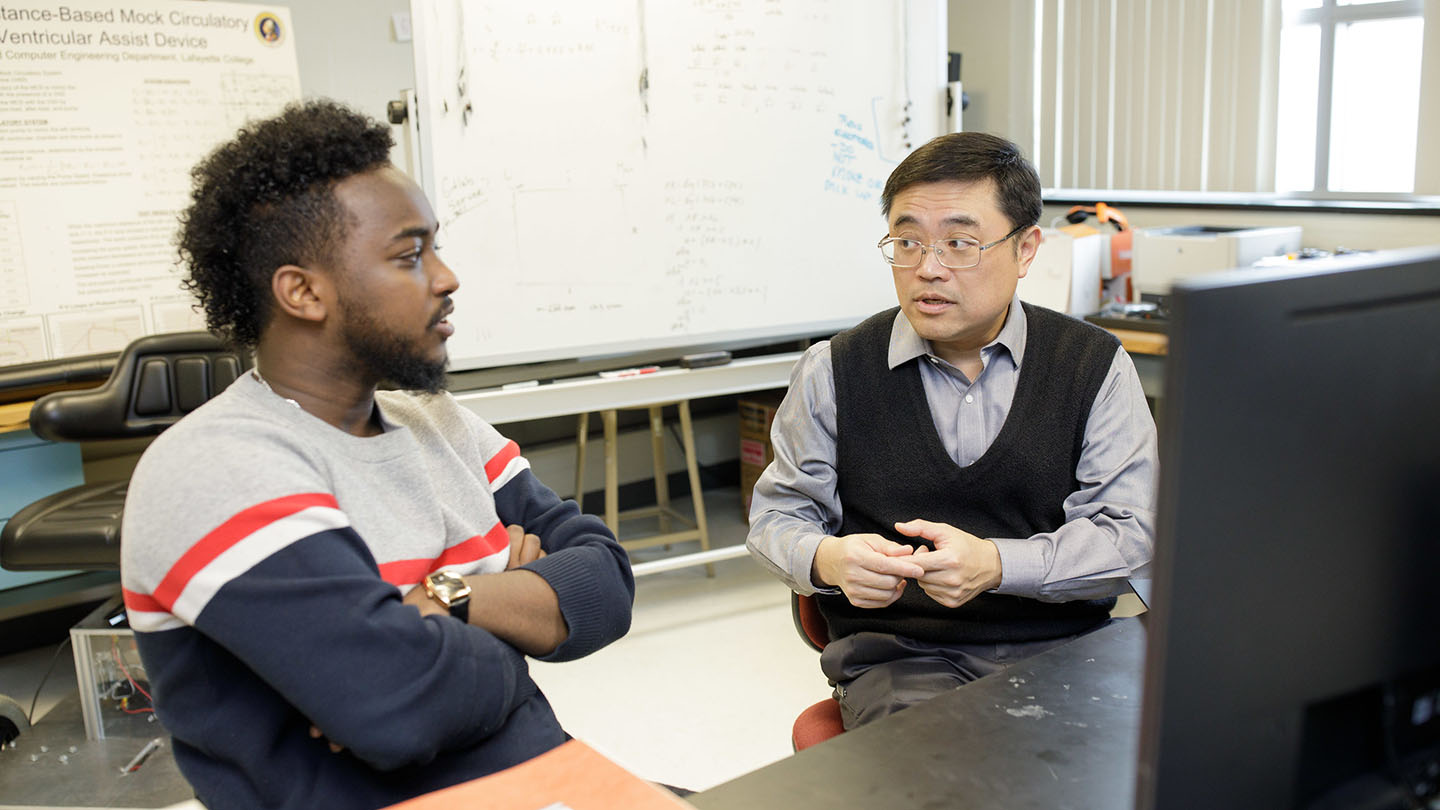Faculty-student research teams work to model cardiovascular system and develop cost-effective blood pressure monitoring
By Bryan Hay
Behind every cardiologist and cardiac surgeon are engineers working to perfect ways to monitor the functions of the most essential organ in the human body, and Lafayette is doing its part to advance that tradition.
Jenn Rossmann, professor of mechanical engineering, began her work in graduate school on modeling blood flow to more fully understand the effects of treatment.
“It was the driving question—how can engineering knowledge improve or collaborate with medical diagnosis and treatment? That really motivated me, the life and death stakes for these equations that I already loved,” she says. “Now I can have this impact on how you would sequence an MRI or how you might affect some treatment of cardiovascular disease.”
Now Rossmann is working with Remziye Erdogan ’20 (mechanical engineering) to model the entire cardiovascular system—tens of thousands of miles of veins, capillaries, and arteries. Simplifying how to look at the network systematically will help clinicians understand how resistance from a device such as a stent will affect blood flow further on down the arterial tree.
“I did lumped parameter modeling of aortic pressure, which is basically a way to simplify computational models of the cardiovascular system and make them easier to interpret,” Erdogan says.
“The more we can model blood flow and predict it, the better that information can be used to plan the treatment of cardiovascular disease,” Rossmann adds.
By way of analogy, the same mathematical model that can be used for an electric circuit can be used for the cardiovascular system. “The same set of equations applies to the cardiovascular system as they do for an electric circuit,” Erdogan says, noting that a pressure difference pushes blood through an artery in a way similar to a voltage difference pushing electrical current.
The aorta was selected for the study because it’s directly connected to the heart by the aortic valve and is representative of how other major arteries react during rest and exercise.
Erdogan says this technique is useful because the cardiovascular system is vast and complex. “Modeling cardiovascular flow using the electrical circuit analogy makes all the math much simpler to work with,” she says.
“I was looking at what happens to the cardiovascular system when the body is at rest compared to it being in an exercise state. There are a lot of changes in the fluid dynamics of your blood when you exercise. The flow rate changes, blood pressure increases, and the heart rate goes up.”
Erdogan is excited about the work because it can be applied to the cardiovascular system in its entirety and, with more refinement, can accurately model blood pressure not only in the aorta but also in other major arteries in the human body.
“Knowing how the cardiovascular system responds when these changes are made has big implications,” she says. “With this technique, you can develop broad models and look at trends throughout the entire body.”
 Cost-effective blood pressure monitoring
Cost-effective blood pressure monitoring
Prof. Yih-Choung Yu and Robson Adem ’19 (electrical and computer engineering) are also looking at the heart as an electrical circuit as they research a more cost-effective way to monitor blood pressure and measure the strength of the heart.
Like Rossmann, Yu, associate professor and head of electrical and computer engineering, began his research when he was a graduate student. In fact, his Ph.D. research was inspired by the defibrillator and heart pump implanted in former Vice President Dick Cheney. Over the years, the work has been advanced by independent study projects and other students who have come through Yu’s classroom.
Yu and Adem are researching how an electrical circuit model can simulate the cardiovascular system, including electrical diodes as heart valves, electrical resistors as fluid resistance in blood vessels, electrical inductors representing fluid inertia, and electrical capacitors representing elasticity of blood vessels and heart chambers.
Physicians who care for patients recovering from heart ailments traditionally rely on expensive echocardiograms to monitor cardiac function (or contractual state of the heart).
“The better way is to monitor the heart 24/7,” Yu says. “We use a computer model to simulate the heart function from very weak for a patient waiting for a transplant to very strong.”
Solutions from mathematical equations represent the blood pressures and flow rate of the cardiovascular system. One particular area of interest in this project is to simulate a diseased cardiovascular system supported by a left ventricular assist device (LVAD), a mechanical device implanted in a patient’s chest to help a diseased heart pump blood.
“Our goal is to use this model to formulate indices representing the healthy status of the cardiovascular system that can be detected without invasive sensors or costly procedures,” Yu says.
“By monitoring those indices, a physician can closely study the recovery of patient’s heart over time and determine the health status of a patient,” Adem adds. “This is significant because it alleviates the financial burden associated with using expensive medical technology including echocardiograms and invasive surgical procedures. Less frequent use of such technologies to monitor a patient’s health would save the cost in the health care industry.”
Successful development of the research would allow clinicians to monitor the cardiac functions of those patients supported by a LVAD with fewer cardiac imaging procedures, which provides the advantages of less risk from LVAD support intervention, better freedom of movement, and lower cost of care.
 Cost-effective blood pressure monitoring
Cost-effective blood pressure monitoring